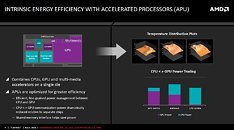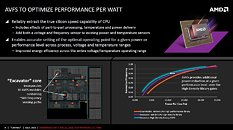- Joined
- Oct 9, 2007
- Messages
- 47,853 (7.39/day)
- Location
- Dublin, Ireland
| System Name | RBMK-1000 |
|---|---|
| Processor | AMD Ryzen 7 5700G |
| Motherboard | Gigabyte B550 AORUS Elite V2 |
| Cooling | DeepCool Gammax L240 V2 |
| Memory | 2x 16GB DDR4-3200 |
| Video Card(s) | Galax RTX 4070 Ti EX |
| Storage | Samsung 990 1TB |
| Display(s) | BenQ 1440p 60 Hz 27-inch |
| Case | Corsair Carbide 100R |
| Audio Device(s) | ASUS SupremeFX S1220A |
| Power Supply | Cooler Master MWE Gold 650W |
| Mouse | ASUS ROG Strix Impact |
| Keyboard | Gamdias Hermes E2 |
| Software | Windows 11 Pro |
AMD gave us a technical preview of its next-generation "Carrizo" APU, which is perhaps the company's biggest design leap since "Trinity." Built on the 28 nm silicon fab process, this chip offers big energy-efficiency gains over the current-generation "Kaveri" silicon, thanks to some major under-the-hood changes.
The biggest of these is the "Excavator" CPU module. 23 percent smaller in area than "Steamroller," (same 28 nm process), Excavator features a new high-density library design, which reduces die-area of the module. Most components are compacted. The floating-point scheduler is 38% smaller, fused multiply-accumulate (FMAC) units compacted by 35%, and instruction-cache controller compacted by another 35%. The "Carrizo" silicon itself uses GPU-optimized high-density metal stack, which helps with the compaction. Each "Excavator" module features two x86-64 CPU cores, which are structured much in the same way as AMD's previous three CPU core generations.




The compaction in components doesn't necessarily translate into lower transistor-counts over "Kaveri." In fact, Carrizo features 3.1 billion transistors (Haswell-D has 1.4 billion). Other bare-metal energy optimizations include an 18% leakage reduction over previous generation, using faster RVT components, which enables 10% higher clock speeds at the same power-draw (as "Kaveri"). A new adaptive-voltage algorithm reduces CPU power draw by 19%, and iGPU power draw by 10%. AMD introduced a few new low-power states optimized for mobile devices such as >9-inch tablets and ultra-compact notebooks, which reduces overall package power draw to less than 1.5W when idling, and a little over 10W when active. In all, AMD is promising a conservative 5% IPC uplift for Excavator over Steamroller, but at a staggering 40% less power, and 23% less die-area.



The integrated-GPU is newer than the one featured on "Kaveri." It features 8 compute units (512 stream processors) based on Graphics CoreNext 1.3 architecture, with Mantle and DirectX 12 API support, and H.265 hardware-acceleration, with more than 3.5 times the video transcoding performance increase over "Kaveri." For notebook and tablet users, AMD is promising "double-digit percentage" improvements in battery life.
Now, if only AMD can put six of these leaner, faster, and greener "Excavator" modules onto an AM3+ chip.
View at TechPowerUp Main Site
The biggest of these is the "Excavator" CPU module. 23 percent smaller in area than "Steamroller," (same 28 nm process), Excavator features a new high-density library design, which reduces die-area of the module. Most components are compacted. The floating-point scheduler is 38% smaller, fused multiply-accumulate (FMAC) units compacted by 35%, and instruction-cache controller compacted by another 35%. The "Carrizo" silicon itself uses GPU-optimized high-density metal stack, which helps with the compaction. Each "Excavator" module features two x86-64 CPU cores, which are structured much in the same way as AMD's previous three CPU core generations.




The compaction in components doesn't necessarily translate into lower transistor-counts over "Kaveri." In fact, Carrizo features 3.1 billion transistors (Haswell-D has 1.4 billion). Other bare-metal energy optimizations include an 18% leakage reduction over previous generation, using faster RVT components, which enables 10% higher clock speeds at the same power-draw (as "Kaveri"). A new adaptive-voltage algorithm reduces CPU power draw by 19%, and iGPU power draw by 10%. AMD introduced a few new low-power states optimized for mobile devices such as >9-inch tablets and ultra-compact notebooks, which reduces overall package power draw to less than 1.5W when idling, and a little over 10W when active. In all, AMD is promising a conservative 5% IPC uplift for Excavator over Steamroller, but at a staggering 40% less power, and 23% less die-area.



The integrated-GPU is newer than the one featured on "Kaveri." It features 8 compute units (512 stream processors) based on Graphics CoreNext 1.3 architecture, with Mantle and DirectX 12 API support, and H.265 hardware-acceleration, with more than 3.5 times the video transcoding performance increase over "Kaveri." For notebook and tablet users, AMD is promising "double-digit percentage" improvements in battery life.
Now, if only AMD can put six of these leaner, faster, and greener "Excavator" modules onto an AM3+ chip.
View at TechPowerUp Main Site
Last edited:







